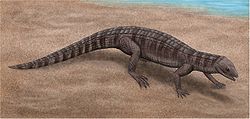- Montsecosuchus
-
Montsecosuchus
Temporal range: Early Cretaceous
Scientific classification 
Kingdom: Animalia Phylum: Chordata Class: Reptilia Superorder: Crocodylomorpha Family: †Atoposauridae Genus: †Montsecosuchus
Buscalioni and Sanz, 1990Species - †M. depereti Vidal, 1915 (type)
Montsecosuchus is an extinct genus of atoposaurid crocodylomorph. It is the replacement generic name for Alligatorium depereti, which was described in 1915 from the Montsec Lithographic Limestone quarry of Spain.[1] Fossils found from this locality are from the Early Cretaceous, being Upper Berriasian-Lower Valanginian in age.[2] While many publications concerning atoposaurids after 1915 have included mentions of A. depereti, none have offered a redescription or revision of the species, even though some recognized that there were great differences between it and other members of the genus.[3][4] It was noted in these publications that the skull of A. depereti was shorter in relation to body length than any other species of Alligatorium (being less than half of the presacral length), and that this may have been evidence for the genetic distinction of the species, although no replacement name was proposed.[5][6] However, better preparation of the holotype specimen MGB 512, a nearly complete articulated skeleton embedded in a limestone matrix now housed in the Museo de Geología del Ayuntameinto de Barcelona, allowed for a revision of the species in 1990 in which the name Montsecosuchus was first used.[7]
Montsecosuchus differs in several ways from other atoposaurids such as Alligatorium, Alligatorellus, and Theriosuchus. Several characteristics of the skull including the presence of an ungrooved parietal-squamosal suture and a caudally projecting retroarticular process distinguish Montsecosuchus from these genera. Both Montsecosuchus and Alligatorellus possess three sacral vertebrae: this may be a shared synapomorphy of the two genera. The shortness of the radius is an autapomorphy of the genus that is not seen in any other atoposaurid, although it is common in more derived crocodylomorphs.
References
- ^ Vidal, L. M. (1915). "Nota geológica y paleontológica sobre el Jurásico superior de la provincia de Lérida". Boliten del Instetuto Geolóico de España 16: 17–55.
- ^ Peybernes, B.; and Oertli, H. (1972). "La série de passage du jurassique au Crétacé dans le Bassin sud-pyrénén (Espagne)". Compte Rendus de l'Académie des Sciences, Paris 274: 3348–3351.
- ^ Broili, F. (1932). "Der obere Jura von Montsech (Provinz Lérida) im Vergleich mit den Ob. Jura-Vorkommen von Cerin (Dept. Ain) und von Franken". Geologica Méditerranea Occidentalis 2: 3–11.
- ^ Steel, R. (1973). "Crocodylia". In O. Kuhn, (ed.). Handbuch der Paläoherpetologie. Stuttgart: Gustav Fischer Verlag. pp. 116 pp..
- ^ Wellnhofer, P. (1973). "Die Atoposauridae (Crocodylia, Mesosuchia) der oberjura-Plattenkalke Bayernes". Paleontographica, A 138: 113–165.
- ^ Buffetaut, E. (1982). "Radiation évolutive, paléoécologie et biogéographie des Crocodiliens mésosuchiens". Mémoires, Société Géologique de Frace 60: 1–88.
- ^ Buscalioni, A. D.; and Sans, J. L. (1990). "Montsecosuchus depereti (Crocodylomorpha, Atoposauridae), new denomination for Alligatorium depereti Vidal, 1915 (Early Cretaceous, Spain): Redescription and phylogenetic relationships". Journal of Vertebrate Paleontology 10 (2): 244–254. doi:10.1080/02724634.1990.10011810.
This article about a prehistoric archosaur is a stub. You can help Wikipedia by expanding it.
